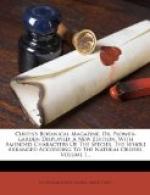From this circumstance we learn, that this species is a native of South Carolina, and properly a bog plant, growing spontaneously with the Dionaea Muscipula.
Both Mr. DRYANDER and Dr. J. E. SMITH assure me, that it is the true Limodorum tuberosum of LINNAEUS; the one usually called by that name is a native of the West-Indies, and treated as a stove plant.
From the little experience we have had of the management of this species, it appears to us to be scarcely hardy enough for the open border, yet not tender enough to require a stove. We have succeeded best by treating it in the manner above mentioned; we may observe, that the tan-pit spoken of was built in the open garden, not in a stove, and was for the purpose of raising plants or seeds by a gentle heat, as well as for striking cuttings and securing plants from cold in the winter.
Our figure will make a description of the plant unnecessary, its flowering stem with us has arisen to the height of a foot and a half, the number of flowers has not exceeded five. In its most luxuriant state it will probably be found much larger, and to produce more flowers.
[117]
CAMPANULA CARPATICA. CARPATIAN BELL-FLOWER.
Class and Order.
PENTANDRIA MONOGYNIA.
Generic Character.
Corolla campanulata fundo clauso valvis staminiferis.
Stigma
trifidum. Capsula
infera poris lateralibus dehiscens.
Specific Character and Synonyms.
CAMPANULA carpatica foliis glabris cordatis
serratis petiolatis,
pedunculis elongatis,
calyce reflexo glutinoso. Linn. Syst.
Vegetab. ed. 14.
Murr. p. 207. Suppl. p. 140. Jacq.
Hort. v.
i. t. 57.
[Illustration: No 117]
This species of Bell-flower, which takes its name from its place of growth, is a native of the Carpatian Alps, and was introduced into the Royal Garden at Kew, by Professor JACQUIN, of Vienna, in the year 1774.
It flowers in June and July.
As yet it is scarce in our gardens, but deserves to be more generally known and cultivated; its flowers, in proportion to the plant, are large and shewy: like many other Alpine plants, it is well suited to decorate certain parts of rock-work, or such borders of the flower garden, as are not adapted for large plants.
It is a hardy perennial, and propagated by parting its roots in autumn.
Our figure, from a deficiency in the colouring art, gives a very inadequate idea of its beauty.
[118]
SEDUM ANACAMPSEROS. EVERGREEN ORPINE.
Class and Order.
DECANDRIA PENTAGYNIA.
Generic Character.
Cal. 5-fidus. Cor. 5-petala. Squamae
nectariferae 5, ad basin
germinis. Caps.
5.
Specific Character and Synonyms.




